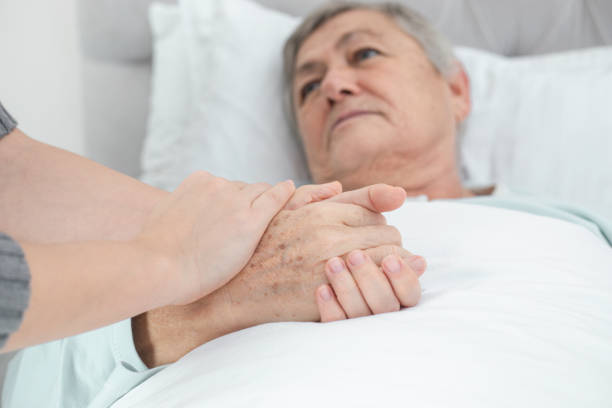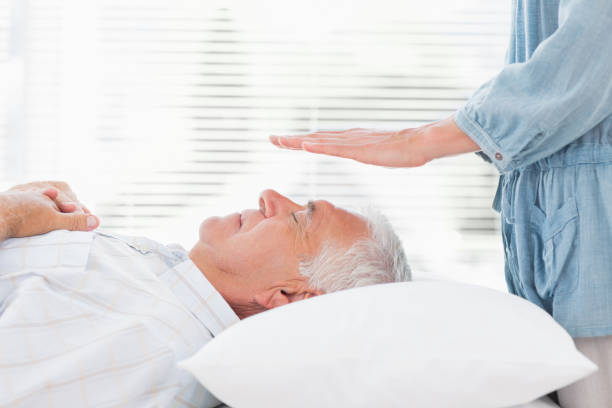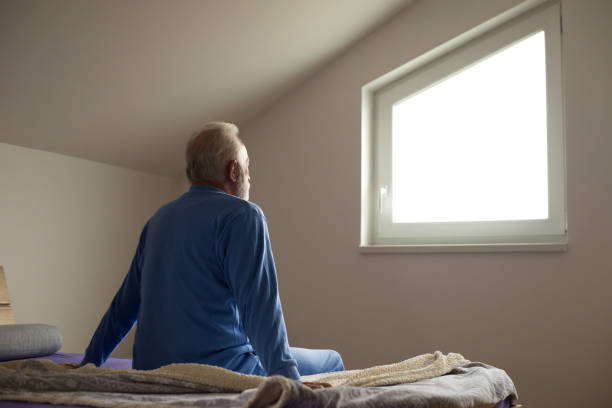Introduction

Do you or someone you know live with Parkinson's? Managing the daily impacts of living with this chronic illness can be daunting, and problems like body stiffness and subsequent mobility restrictions can lead to feelings of helplessness. Fortunately, there are various strategies that individuals can use to exercise control over their wellness and minimize complications associated with movement.
In this blog post, we will explore proven techniques to support safe movement in bed for people living with Parkinson's so they may find relief from uncomfortable symptoms while increasing independence!
Overview of Parkinson's Disease and its Impact on Mobility
Parkinson's is a progressive neurological disorder affecting an estimated one million people in the United States and 10 million worldwide. This condition is marked by various symptoms affecting movement, thinking, involuntary bodily functions, and behavior. Even though specific symptoms may differ between individuals, typical signs of this condition include tremors, reduced movement speed, limb stiffness, balance difficulties, and weakened reflexes.
As the disease progresses, some individuals living with Parkinson's may require assistance to move in bed due to physical difficulties. Care providers and family members must know techniques supporting safe movement for people with Parkinson's.
Techniques to Support Safe Movement in Bed
1. Reducing Muscle Tone
People living with Parkinson's often experience increased muscle tone, which can limit their range of motion. Care providers and family members should aim to reduce muscle tone by gently stretching the affected area before attempting any movement in bed.
2. Body Positioning
Care providers and family members should consider the body positioning of a person with Parkinson's before beginning any movement. A comfortable position should be found conducive to movement and does not stress the body.
3. Use of Leverage
Care providers should use leverage when assisting to help reduce strain on their bodies and prevent injury. For example, if transferring from a bed to a wheelchair, care providers should use their body weight and strength to push up on the affected person instead of pulling.
4. Proper Lifting Technique
When it comes to lifting an individual with Parkinson's, it is advised to use labor saving devices as there is no safe way to manually lift when the load is too great. It is estimated that 25 pounds should be the maximum weight to lift – yet, this amount might be excessive for some people depending on their own risk factors. Care providers need to follow safe transfer techniques to avoid injury and to use mechanical devices or friction-reducing aids to reduce the strain.
These techniques are important for care providers and family members to be aware of when assisting someone living with Parkinson's in bed. By adhering to these guidelines, care providers can ensure safe and comfortable movements for people with Parkinson's.
Strategies to Improve Posture While in Bed
For people with Parkinson's, avoiding prolonged or uncomfortable positions while in bed can be a challenge. Fortunately, there are several techniques to support safe movement and help improve posture throughout the night.
One strategy is to equip your bed with specially designed pillows and body wedges that encourage proper spinal alignment as you sleep. The right wedge or pillow can provide extra support to the neck, back, and hips while helping to minimize pressure points.
Consider adding an adjustable bed base for easier adjustment of your sleeping position. This movement can help alleviate cramping and stiffness associated with Parkinson's and reduce the risk of developing painful pressure ulcers.
Finally, an adjustable bed rail can also benefit those with Parkinson's who may have difficulty getting in and out of bed independently. The rail provides a stable surface to transfer from a wheelchair or walker and a secure grip to support rising from the bed. Additionally, it can help reduce falls that are more common with Parkinson's due to difficulty balancing and adjusting to changes in position.
By utilizing these strategies, people living with Parkinson's can take measures to support safe movement while in bed and help improve their overall posture throughout the night.
Tips to Manage Agitation and Facilitate Restful Sleep

It is important to use techniques to support safe bed movement for people with Parkinson's. These techniques can help reduce agitation and promote restful sleep.
1. Establish an evening routine
Set aside a few moments each night to review the day and practice deep breathing or relaxation exercises. Routines provide structure and comfort, which can help relieve stress and tension.
2. Create a comfortable sleeping environment
Choose bedding, pillows, mattress, and blankets that encourage relaxation and ease of mobility. Use darkening curtains or shades to block out light to promote sleep.
3. Exercise regularly
Regular exercise throughout the day can help improve movement at night. This helps reduce stiffness and can improve sleep-wake cycles. However, exercise only a little time as it may have the opposite effect and make it harder to fall asleep.
4. Relax
Relaxation techniques such as yoga, tai chi, and meditation can help reduce stress and anxiety, leading to better sleep. Incorporate relaxation exercises into your routine.
5. Avoid caffeine and alcohol
Caffeine and alcohol should be avoided late afternoon or evening to reduce stimulation and encourage sleep.
6. Make sure you're getting enough sleep
Getting the right amount of quality rest is essential for people with Parkinson's. Getting between seven to nine hours of sleep every night is recommended, though this can vary depending on individual sleep requirements.
7. Speak with your doctor:
Talk to your doctor about possible treatments or medication options if you are having difficulty sleeping.
Combined, these techniques can help support safe movement in bed and promote restful sleep for people with Parkinson's.
Safety Tips to Support Safe Movement in Bed

Safety is of the utmost importance regarding safe movement in bed. These are some things to remember when you're traveling:
1. Have a caregiver or loved one nearby
Having someone nearby can help in case of a fall or other complications.
2. Move slowly and cautiously
Take your time to avoid sudden movements that could cause falls or injury.
3. Use assistance devices
Support tools such as grab bars, transfer benches, and assistive lifts can make transitioning from bed to chair easier and safer.
4.Use non-slip mats
Using non-slip mats or carpeting in high-foot traffic areas can help reduce the risk of falls.
5. Do exercises to improve balance and coordination
Regular exercise can help improve balance, flexibility, coordination, and overall strength, reducing the risk of falls.
6. Wear protective gear
Wearing a helmet, knee pads, and other supportive safety equipment can help reduce the risk of injury if a fall does occur.
These tips will help you have a safe and comfortable bedtime. If you have questions or concerns about moving safely in bed, speak to your healthcare team. They can provide additional guidance and support.
How to Use Pillows for Supportive Positioning
Pillows can be used to support and protect the body in a variety of positions. Pillows are especially helpful for people with Parkinson's who experience muscle rigidity or feel uncomfortable lying flat on their back for extended periods. Here are a few techniques for using pillows for improved comfort and safety when positioning in bed:
-
Position pillows at your back, hip, and knees to support you while lying inside. They can also be a barrier between your upper body and the bed if you roll around during sleep.
-
Place a pillow between your legs when lying on your side to reduce pressure in the lower back from leg crossing.
-
Try using pillows to raise your legs to relieve pressure on your calves and ankles while lying on your back.
-
Place a pillow behind you while sitting on the side of the bed or in a chair to reduce strain on your joints.
Using these techniques makes your sleeping and resting experiences in bed more comfortable and safe. With the help of a caregiver, pillows can also be used to provide support while turning or transferring in bed. Be sure to follow instructions from your healthcare team when adjusting positioning with pillows or other supports.
With these techniques, people with Parkinson's can be more comfortable and safe when adjusting their positioning in bed. Remembering that a caregiver should always assist with any movement or repositioning for safety reasons is important. With the proper support, people living with Parkinson's can find relief from pain and discomfort when it comes to positioning in bed.
Exercises for Regaining Strength and Balance
Along with safe movement techniques, people living with Parkinson's can benefit from exercises that help to regain strength and balance. Strengthening muscles can help reduce the risk of falls and provide support when moving in bed. Balance exercises can also be beneficial for maintaining safety while sleeping and getting out of bed safely.
Examples of strength and balance exercises include:
Wall Pushups - This exercise strengthens the chest, arms, and shoulder muscles while improving upper body mobility.
Standing Balance Exercises-Various balance exercises can be done while standing to improve overall stability.
Leg Raises - sitting position or lying down with legs bent, slowly lift one leg off the bed and then switch to the other side. This exercise can help increase leg strength and improve balance.
By incorporating these exercises into a routine, people with Parkinson's can experience improved mobility and increased safety while sleeping.
Benefits of Utilizing a Bedside Lift or Transfer Device
For people with Parkinson's, using a bedside lift or transfer device can help you maintain independence and safety while moving from one position to another within your bed.
This helpful tool can reduce your risk of falls and injuries by ensuring you are supported during transfers. Furthermore, a lift or transfer device, such as friction-reducing textiles, can help reduce the manual strain transfers put on caregivers and family members, enabling them to assist easily.
Key points for safely helping someone move
1. Identifying body parts and understanding how they move
2. Exploring the different types of safe movements in bed
3. Learning proper body positioning to support safety
4. Working on joint range of motion exercises for flexibility
5. Utilizing correct breathing techniques for movement stability
6. Develop strategies to reduce discomfort by changing positions
FAQs
How do you get a Parkinson's patient into bed?
Getting a Parkinson's patient into bed safely is best done with the help of a caretaker or medical professional. Depending on the patient's physical limitations, techniques such as transferring to the bed from a wheelchair or using an adjustable bed may reduce the risk of injury. Other strategies include using slide boards, slide sheets, draw sheets, and gait belts. Additionally, friction-reducing garment and sheet sets can allow easier getting in/ out and turning in bed.
What exercise can help people living with Parkinson's?
Exercises focusing on improving balance, flexibility, and mobility aid can benefit people with Parkinson's foundation.
Examples of exercises that may support safe movement in bed include strengthening activities such as leg lifts, hip bridges, and heel slides; balance exercises such as side leg raises and lower-body stretching; and range-of-motion exercises like arm circles and spinal twists.
How will you promote safety for patients with Parkinson's disease?
Promoting safety for people living with Parkinson's disease includes understanding their physical limitations, providing the patient with adequate support during transfers and movement in bed, and using techniques to support the safe movement, such as slide boards, slide sheets, draw sheets, and gait belts.
It is important to consult a medical professional or caretaker who can guide how to safely move the patient in and out of bed. It's also crucial to ensure that there are no situations in the patient's environment that could cause them to slip and fall risk.
What type of bed is best for Parkinson's patients?
For individuals with Parkinson's disease, an adjustable bed might be the most suitable choice. Adjustable beds can provide support and comfort to the patient, making it easier for them to safely move in and out of bed. Additionally, certain safety devices such as side rails may help promote safety for patients as well.
How can I help a Parkinson's patient move in bed?
If you are helping a Parkinson's patient move in bed, it is important to ensure they are in a safe and comfortable position. It may be helpful to use techniques such as transferring the patient with slider sheets. Additionally, it is important to provide adequate support and assistance during the transfer process.
Can you massage someone with Parkinson's?
Yes, massage can be beneficial for people living with Parkinson's disease. Massage helps promote relaxation and reduce muscle tension, which can help improve range of motion and flexibility. However, speaking with a medical professional or caretaker is important to ensure the massage technique is appropriate for the patient's physical limitations.
Conclusion
In conclusion, people with Parkinson's can benefit from safe and comfortable movement in bed to support daily life living. The tips provided above are some techniques that may help with this. Ensuring optimal positioning, using specialized equipment, and adapting furniture to meet individual needs are all important elements for supporting safe movement in bed. Talking to a healthcare professional about physical therapy options that may provide additional support is also beneficial.

